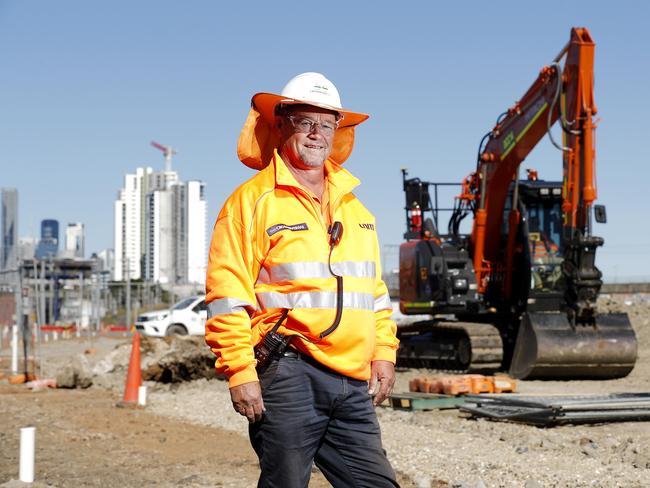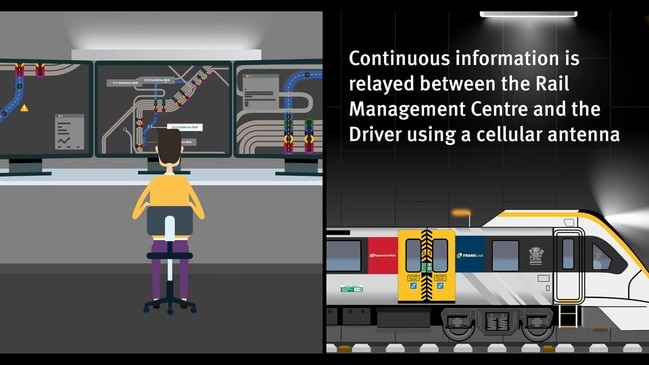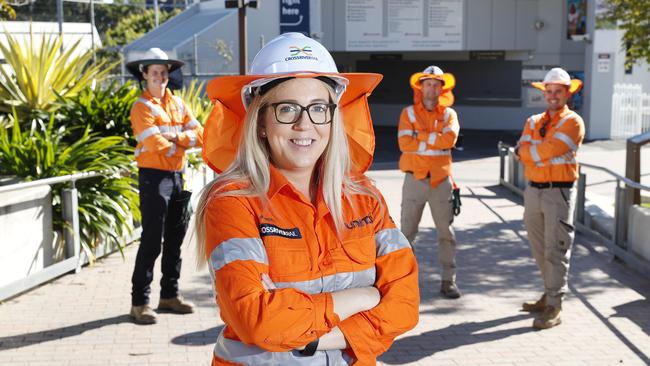Cross River Rail project creates mega jobs
While the engineering feats involved in the $5.4bn Cross River Rail underground that will un-choke Brisbane’s public transport are staggering, in the age of COVID the secure jobs attached to it are equally as impressive.

Future QLD
Don't miss out on the headlines from Future QLD. Followed categories will be added to My News.
TUNNELLING for Queensland’s biggest infrastructure project has kicked off in earnest, with the first 59m of rock bored outlast week to access what will become Brisbane’s 5.9km Cross River Rail underground.
While the engineering feats involved in the $5.4bn underground rail system that will unchoke Brisbane’s public transport are staggering, in the age of COVID, the secure jobs attached to it are equally as impressive. The project is injecting $4.1m per day into the economy, or $125m per month, with 97 per cent of workers on the project living in Queensland.
Cross River Rail Minister Kate Jones said that translated into 2400 workers on the project now, growing to a peak of 3000in the next year to 18 months.
How SEQ’s transport systems are about to be transformed
How Cross River Rail will change our city forever
How Cross River Rail will change peak hour commutes
More than 7700 people will work on Cross River Rail over the five years of construction, with 400 local suppliers signed up and more than 160 apprentice and traineeship positions filled of 450 to be created.
The Sunday Mail, in conjunction with the Cross River Rail Delivery Authority (CRRDA), is presenting a series looking at the project and what it will bring to the state.
Cross River Rail is a 10.2km rail line from Dutton Park to Bowen Hills, which includes 5.9km of twin tunnels under the Brisbane River and Brisbane CBD.
Work has begun on the project’s four new underground stations at Boggo Road, Woolloongabba, Albert Street and Roma Street.

By introducing another river crossing, Brisbane’s rail network can have more trains more often while the underground means less of the CBD is given over to rail tracks, and stations can sit in the city centre. Its backers say a better public transport system will remove thousands of cars from roads.
“We all know that COVID-19 is going to have a significant hit on our economy, whether it’s here in Queensland, Brisbane, Australia or globally,” Ms Jones said. “But one of the great things is the fact we have been able to plough on with some of these major infrastructure projects.”
Ms Jones said the $3.6bn Queen’s Wharf hotels, retail and casino combined with the $5.4bn for Cross River Rail meant billions were being poured into reshaping Brisbane and attracting new business to Queensland.
“That’s infrastructure that continues to be built that will fast-track Brisbane’s economic recovery,” she said.
“It puts Brisbane in a really good position for what economists are saying will take years to get the economy back to pre-COVID-19 size and activity. When you look at the major construction sites whether it’s Woolloongabba, Boggo Road or Roma Street, they are old, ugly eyesores coming down before your eyes and the biggest excavation projects ever undertaken in Brisbane are underway.
“It will ultimately free up hectares of prime real estate for redevelopment at the heart of the city.
“There’s no other city, modern city, that has hectares in its heart to be redeveloped for the best use for the next chapter in our city’s story.”

Tunnelling construction will be completed by 2024, after which a detailed commissioning and testing program will begin.
Delivery authority tunnels, stations and development project director Jeremy Kruger said the benefits of jobs on the underground would flow through the Queensland economy.
“It’s an amazing opportunity for southeast Queensland to have a major project in its backyard,” Mr Kruger said.
“Having all those direct employees on the project is great for those employees and those families, but the benefits go broader as well because you’ve got a supply chain that feeds into the project, you’ve got businesses around the project, whether they be hotels, restaurants.
“You get a real flow-on effect of having all those people employed on the project. Those families have jobs and that flows on into the community.
“And the project is going to roll on for at least four years, so there’s jobs there for a large, large number of people for an extended duration.”
The size and length of the project means apprentices and trainees could start their new jobs on Cross River Rail and get their trade by the time it finishes. “You can bring people in early on in their career, like apprentices, and by the end of the job they can be fully qualified tradespeople,” Mr Kruger said.
While the boring machines have begun work at Roma Street and travelled 59m so far, explosive tests will be conducted at Woolloongabba and Albert Street this month.
Blasting will be done between 7.30am and 4.30pm weekdays or Saturdays.

APPRENTICES READY TO WORK
It’s a pretty decent way to kick off a new career, working on Queensland’s biggest infrastructure project.
And if that new job looks like a pay packet through the biggest international crisis since World War II, so much the better.
Among the 450 apprentices signing on for Cross River Rail, apprentice linesmen Lachlan Wilson, 22, Ryan Sheppard, 34, and Brian Gethins, 35, could not be happier.
Mr Wilson said he had picked up the job at a time when a lot of his mates were being laid off or having their hours cut as COVID-19 bites.
Mr Sheppard and Mr Gethins are among the mature-aged apprentices.
After driving trucks and labouring, Mr Sheppard said an apprenticeship offered the chance to get a trade and job security. Mr Gethins has gone from labouring on the rail lines to getting a trade and the skills that brings.
Training co-ordinator Annica Carberry said the Cross River trainees were all keen to get on with the job.
“To be an apprentice on Cross River Rail and be a part of this project just sells itself for apprentices,” she said.
“It’s giving them an opportunity to get away from casual work or being a labourer to come into a specific role.”
Chris Buchanan, a 30-year construction industry veteran, said Cross River Rail offered plenty of work and hours. He had already taken delivery of the first spoil from the Roma St tunnel last week, which will be used at Mayne Yard at Bowen Hills.
